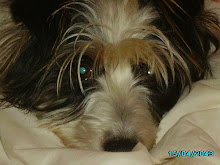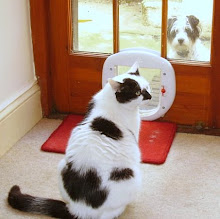
(The Pandora Inn, now famous as being Our Pub While Courting.)
This is the walk that is in the current copy (January) of Cornwall Today - quite by chance as I should have written another one. But this is all about my Pip so I was able to take it in on Christmas Day and show the nurses. Boy was he proud....
A ROMANTIC WALK from Mylor Quay along the creek to the Pandora Inn,
returning via Mylor Bridge
I met my husband, Pip, when he was living on an oyster fishing boat called White Heather, moored near the Pandora, so this thatched pub at Restronguet was our local – a very romantic place to do our courting.
To start the walk, take the A39 Falmouth-Penryn road and at Penryn, take the road signposted to Mylor and continue until you reach Mylor Bridge. At the first roundabout go straight over, then take the first sharp turning on the right, and drive down past the post office to park on Mylor Quay.
It was low tide when I did this walk with John and Annie, and bath time for a party of ducks, splashing and squawking as they dived into pools of water like over-excited children. As we walked along the road following public footpath signs to Greatwood and Restronguet, several swans glided past, looking down their noses at the riff-raff. Just past a circular mirror on the right, we took a footpath parallel to the creek and, being a boating man, John was fascinated by the selection of boats at Tregatreath boatyard opposite.
The path curved round to the left, by a concrete block wall, then we crossed a private road and took the footpath sign ahead on our right, through a squeaky gate which led to a large field. There are often cattle here – and bulls have been known – but thankfully there were none today and we crossed the field, weaved our way through a kind of metal kissing gate and found ourselves on the foreshore.
We turned sharp left along the path that follows the creek; this next bit can be extremely muddy and slippery. On the opposite side of the creek I pointed out the houses along Church Road – a selection of houses in varying shapes and sizes of grandeur. We walked past a ploughed field on our left, full of rich brown earth like chocolate fudge, and noted the very last of the blackberries, and branches coated in feathery fingers of lichen. “Is that pronounced liken or lichen?” I asked.
John and Annie voted for lichen, and whichever it is, it is supposedly a sign of pure air so we breathed that much deeper as we walked.
Passing through another kissing gate, a winding path led us down to an overgrown quarry and on the shore, a couple of tired old boats, lapping up the sun in their last resting place. The path continued round to the right and another five barred gate into another field, then through that, to another little inlet with yet more decaying boats and a carefully positioned swing hanging from a tree over the beach. Being a painter, Annie was cursing herself for not having brought her sketch book, but as the sun made an appearance, took photographs so she can paint them later.
Passing through another wooden kissing gate and a muddy quagmire, we crunched our way through autumn gold leaves and up into another field, following a path diagonally uphill past a massive oak tree with branches trailing like a dowager's dress, through which the creek sparkled like diamonds.
At the top of this hill was a dead tree, branches grasping their way skywards. The path now tumbled down the other side of the hill and as we looked out to sea, saw moorings, in lurid shades of pink and green, like gobstoppers perched on the foreshore. Passing through another wooden kissing gate, we continued along a path strewn with acorns until we reached Greatwood Quay, where we stood looking out at the waters of Carrick Roads, the Roseland Peninsula, and Mylor Harbour, where there used to be a naval dockyard. The remaining boats of the season were bobbing on the waves and the nearest of these belonged to BATS – Blind At Sea – who often sail on these waters.
Greatwood Quay is a listed building built in the 18th century, of vertically-set dry slatestone with dressed granite copings linked by iron staples. This beautifully built quay was a landing stage for Greatwood House, further along this path.
As we continued along the path, we counted five oyster fishing boats out in the Carrick Roads: because oysters breed in the summer, fishing is restricted to October until April only. The Cornish have dredged for oysters in this area of the river Fal for over a century, and some of the boats, built at local boatyards, date back as far as 1860. Ancient laws were put in place to protect the natural ecology of the riverbeds and oyster stocks, stating that oystermen fishing in the Port of Truro Oyster Fishery are banned from using engines. Only sail power and hand-pulled dredges are permitted, although boats are allowed to motor out to the oyster beds. This is the only oyster fishery in Europe, if not the world, where such traditional methods must be used, and watching a fisherman at work is a real art.
Pip has owned several of these splendid wooden boats (known as “working boats” locally), one of which we did our courting on. The year before we met, his brother took over their business to enable him to have a season oystering, fulfilling a lifelong ambition. “It was incredibly hard work,” he said. “I lost over 3 stone, but I learnt so much from the oyster fishermen, and I was lucky to have such an incredible experience.”
We continued along the path, uphill through the woods, and turned right, from where we could see Greatwood House, once a vast turreted mansion but now converted to flats with fabulous views out over the Carrick Roads. Further on was a row of small cottages, and the path continued past some old stables under renovation. There used to be several Shetland ponies that grazed here: it always amazed me that they could graze at such an angle.
Further on Gunnera leaves towered over us, like huge plants from a nightmare, but we crept past, my imagination working overtime, and continued until we reached Weir Beach, where Mollie loves chasing the swans. Until they hiss back. There is often a solitary heron here, and a black swan that became quite famous. Today we spotted a lone egret, curlews and a cormorant, perched on a buoy, drying his wings.
Leaving Weir Beach behind, we continued along the path until we reached the Pandora where Pip was waiting, drinks at the ready. After a brief interlude we climbed up Restronguet Hill, which is extremely steep and narrow. Towards the top where it flattened out, I pointed out a telegraph pole where, not long after we met, Pip stuck a notice there announcing, 'Pip loves Curls'.”
Gossip was rife among the local community, wondering who owned said curls.
We reached a crossroads shortly after this and headed down the hill, through Mylor Bridge. Being ravenous by the time we reached the foot of the hill, we paid a visit to the butcher, then turned left and arrived back on the quay. The tide was coming in fast as we sat on a bench, eased off our boots, and tucked into excellent home made pasties.
John pointed out some swans gliding serenely past. “That was a lovely walk - I really enjoyed seeing your old stamping ground.” He paused and looked at me. “Though I do think you should put a blue plaque on that telegraph pole.”
FACTBOX
OS Explorer 105 Falmouth & Mevagissey
Length: 1.5 -2 hours
Duration: 3 miles
Grading: easy going, though can be very muddy. The hill up from the Pandora is very steep.
Refreshments: Pandora Inn www.pandorainn.com 01326 3726768
Lemon Arms, Mylor Bridge 01326 373666
Various shops in Mylor Bridge
















